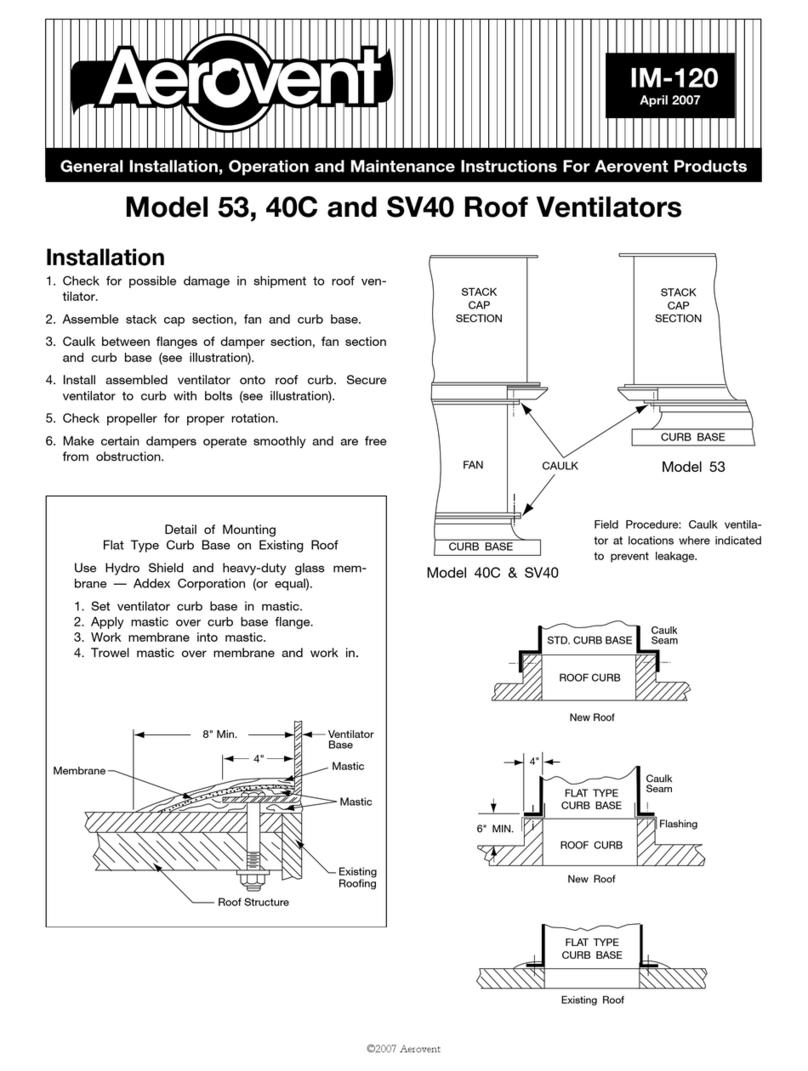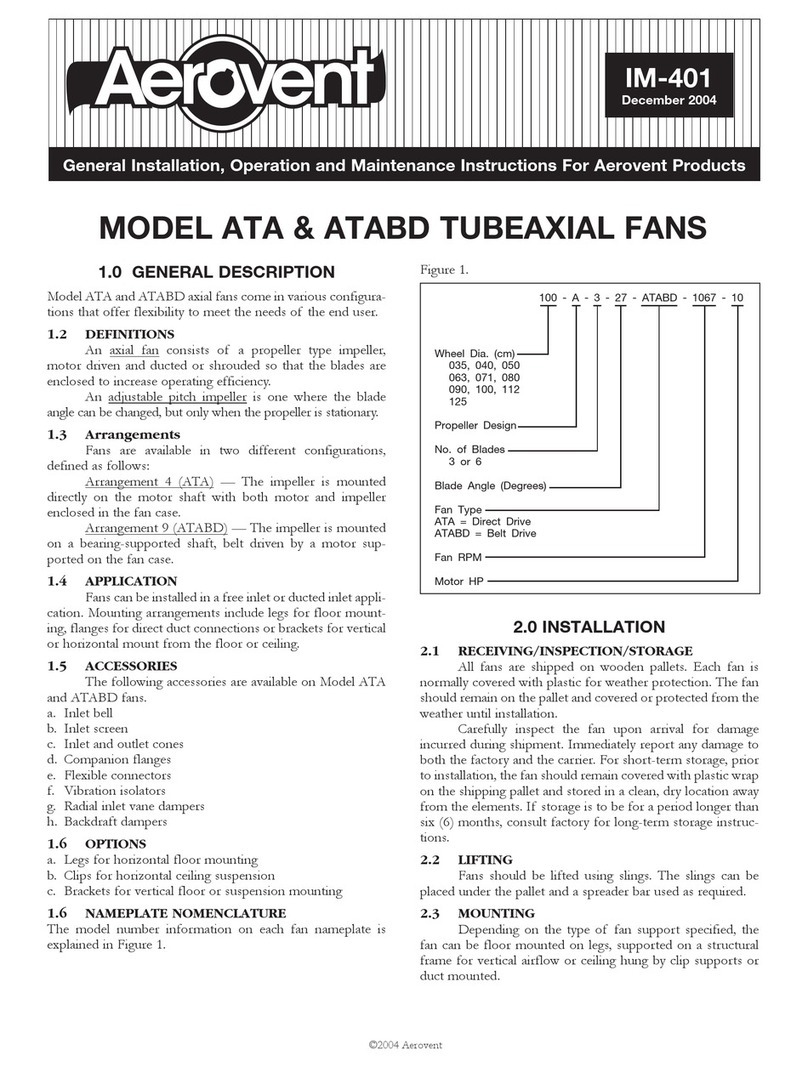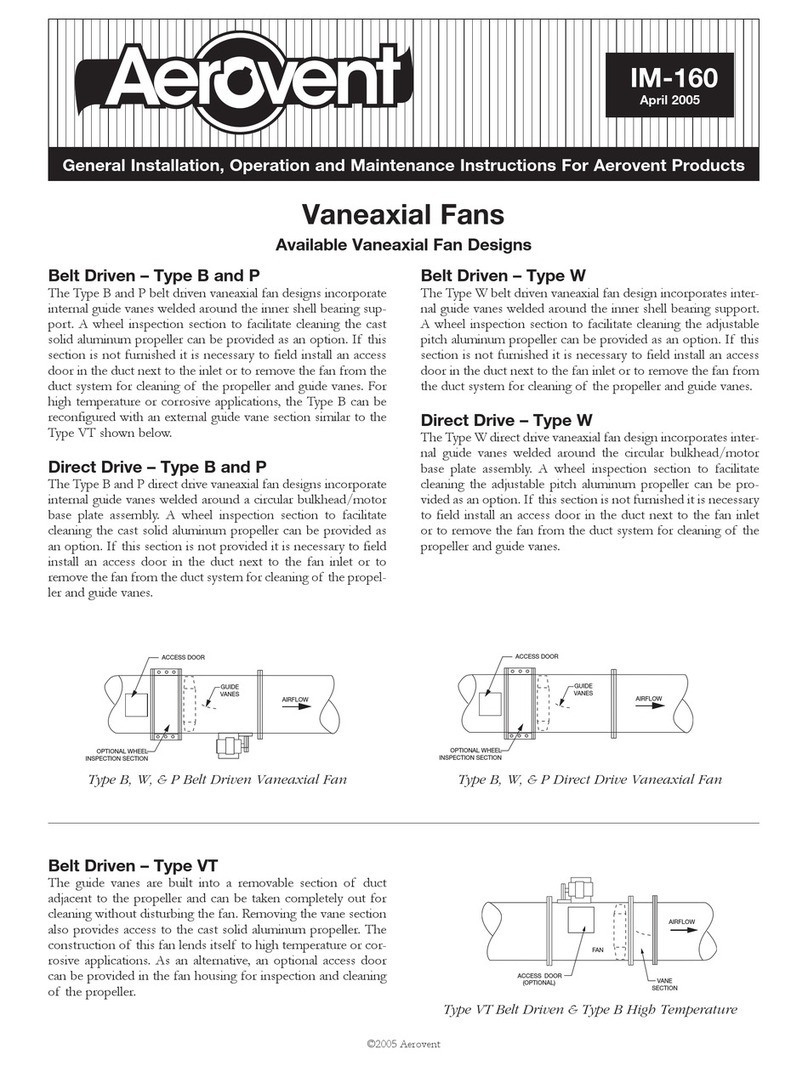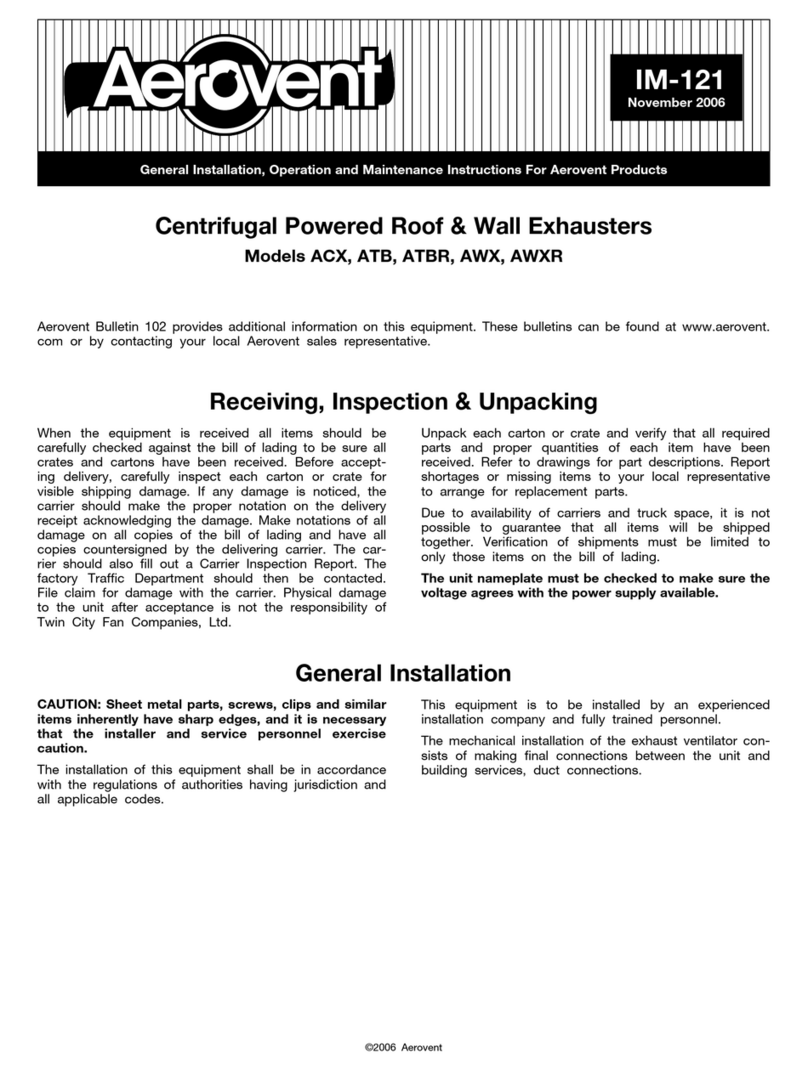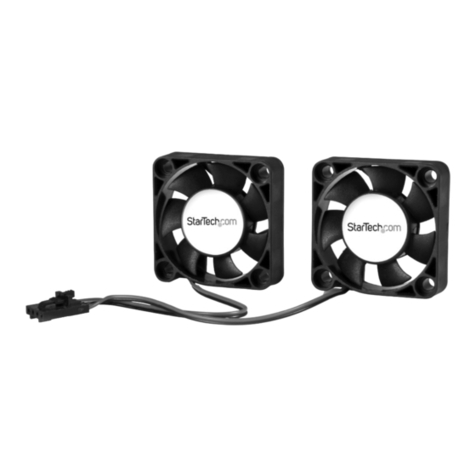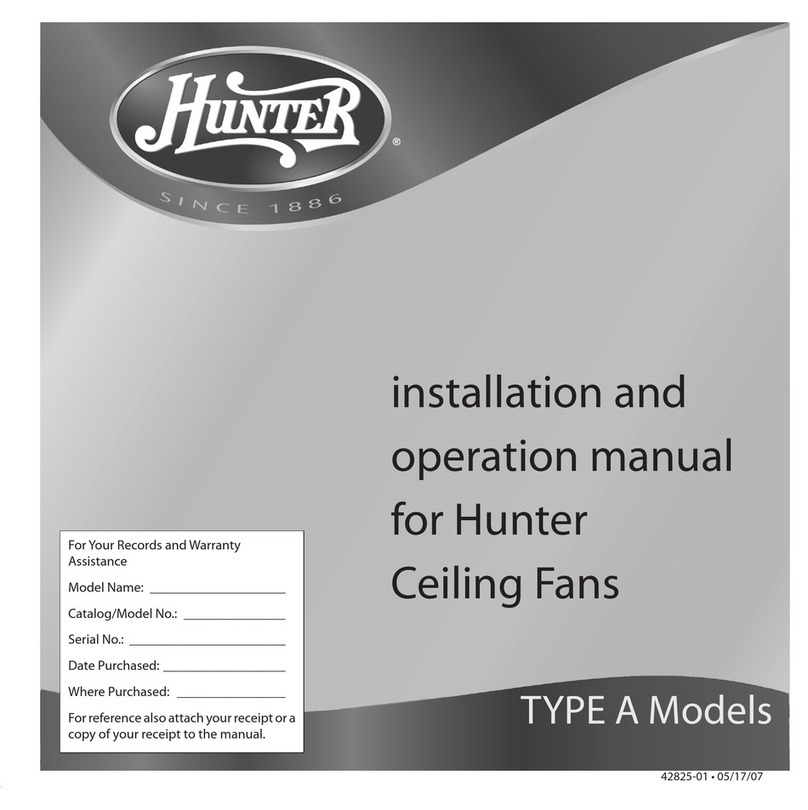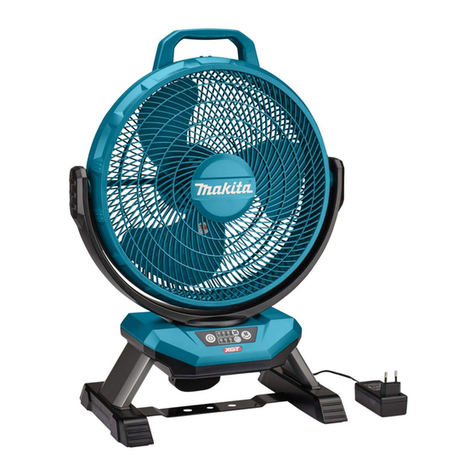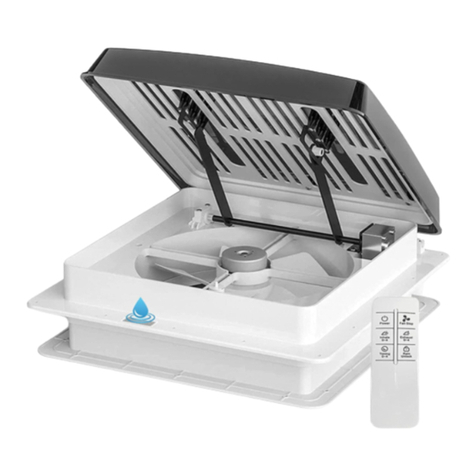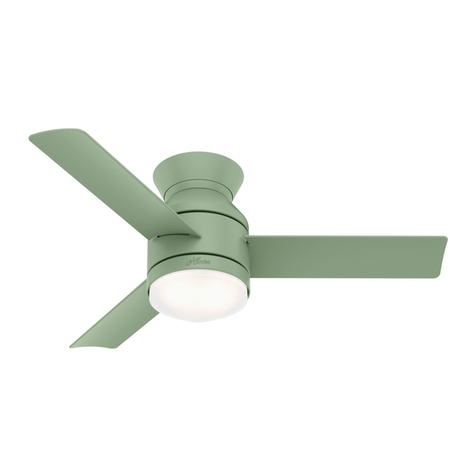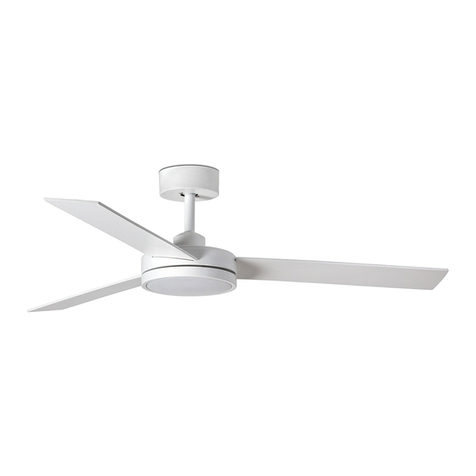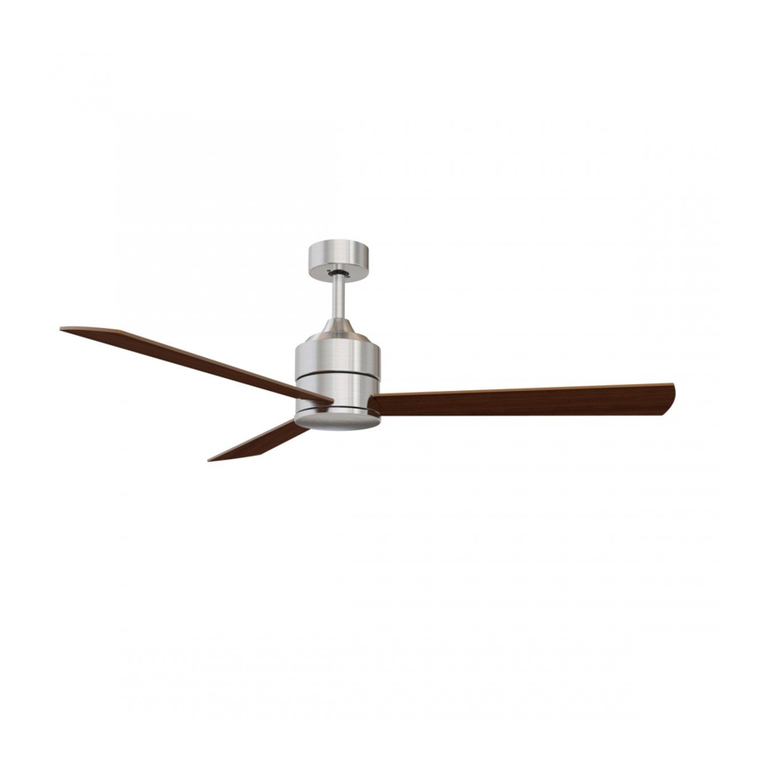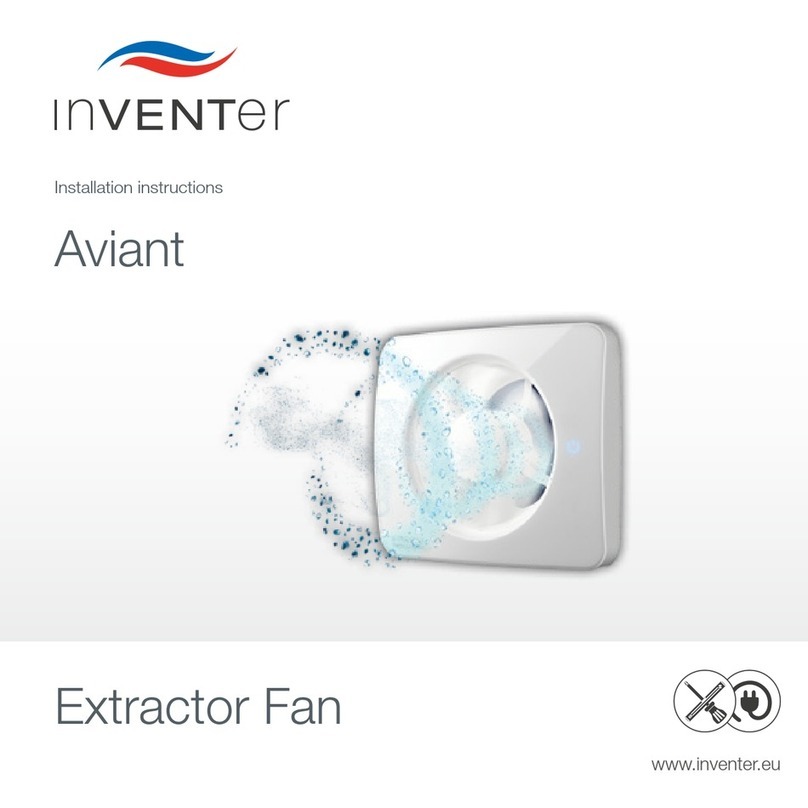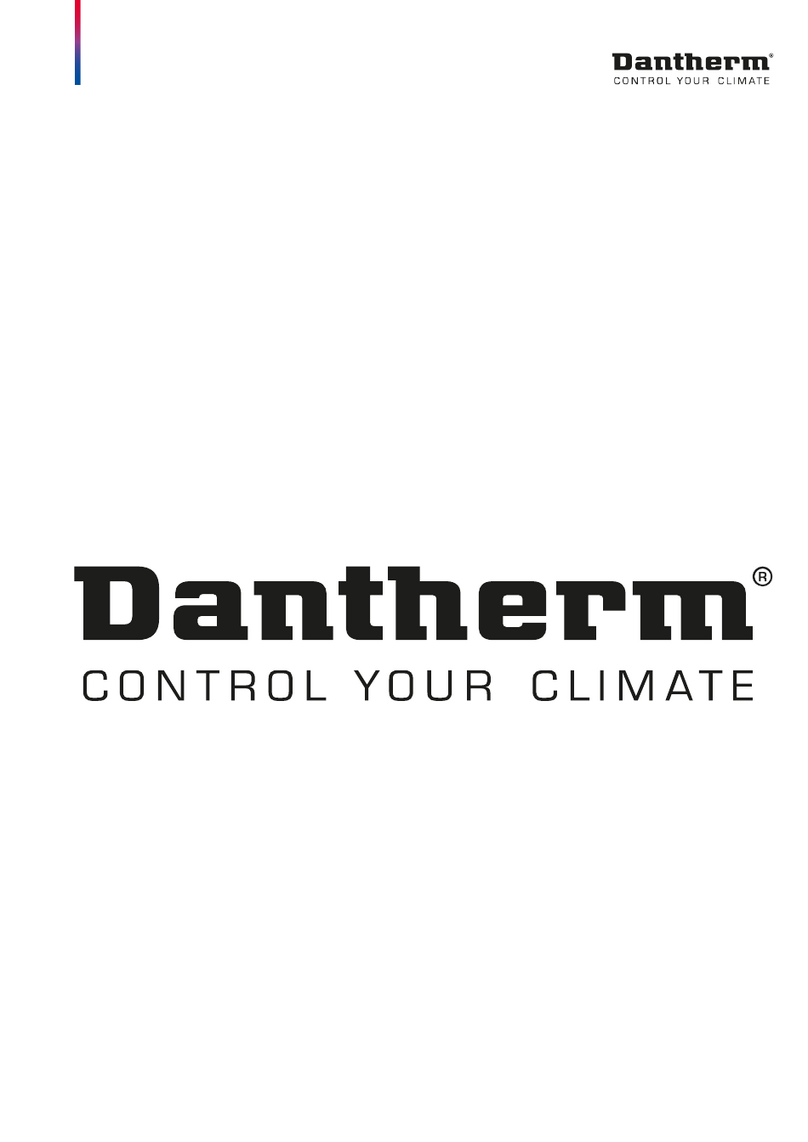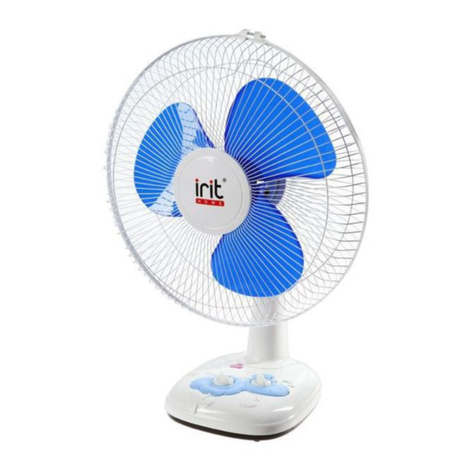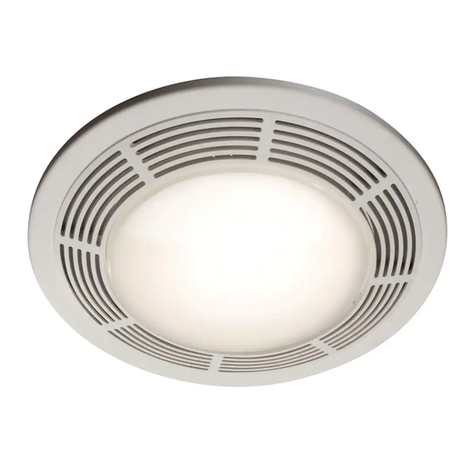Aerovent IM-166 Instruction manual

Centrifugal Fans
Installation, Operation & Maintenance Manual
Mixed Flow Fans
IM-166
August 2022
This manual has been prepared to guide the users of mixed flow fans in the proper installation, operation and maintenance procedures
to ensure maximum equipment life with trouble-free operation. For safe installation, startup and operational life of this equipment,
it is important that all involved with the equipment be well versed in proper fan safety practices and read this manual. It is the user’s
responsibility to make sure that all requirements of good safety practices and any applicable safety codes are strictly adhered to.
Because of the wide variety of equipment covered in this manual, the instructions given here are general in nature. Additional product
and engineering information is available at www.aerovent.com.
REVIEW AMCA PUBLICATION 410 PRIOR TO INSTALLATION
Table of Contents
Fan Arrangements........................................................................2
Exploded View..............................................................................2
Impeller Nomenclature................................................................3
Impeller Rotaon .........................................................................3
Safety & Hazard Warnings ...........................................................4
Shipping & Receiving....................................................................4
Handling .......................................................................................5
Unit Storage .................................................................................6
Foundaons and Supporng Structures...................................7-8
Fan Installaon, Factory Assembled Units...................................9
Bearing Installaon ....................................................................10
Safety & Bearing Lubricaon Instrucons .................................11
Drive Mounng ..........................................................................12
Motor Support Adjustment .......................................................13
Maintenance ..............................................................................13
Motor Maintenance...................................................................13
Drive Maintenance.....................................................................14
Fan Bearing Maintenance ..........................................................14
Impeller and Sha Maintenance ...............................................14
Structural Maintenance .............................................................15
Duct Connecons.......................................................................15
Serial Number & Fan Type Nameplate ......................................15
Impeller Placement / Impeller Overlap .....................................16
Troubleshoong Guidelines .......................................................17
Installaon / Start-up Checklist..................................................18
Fan Maintenance Log.................................................................19
Refer to the safety section(s) in this manual prior to installing or servicing the fan. The most current version of this installation and maintenance
manual can be found on our website at www.aerovent.com/resources/im-manuals.
SAFETY NOTICE

Installation, Operation & Maintenance Manual
IM-166
2
Fan Arrangements
Arrangement 3
Belt Driven
Arrangement 4
Direct Drive
Exploded View
Arrangement 9
Belt Driven
Inlet
Funnel
Sheave/Pulley
Impeller
Bearing Housing
With End Cover
Plate Belt Tube &
Straightening Vanes
Discharge Cone &
Belt Tube Seal
(Removable)
Housing
Motor
Mount
Bearings
Shaft
Motor
Belt

Installation, Operation & Maintenance Manual IM-166
3
Impeller Cone
(End Ring, Shroud, Front Plate)
Back Plate
Blade
Impeller Nomenclature
AIRFLOW
Impeller Rotation
CLOCKWISE (CW)
example shown
Rotation View From Drive Side

Installation, Operation & Maintenance Manual
IM-166
4
Safety & Hazard Warnings
For general safety practices for air moving equipment, see AMCA Bulletin 410. Aerovent offers many safety accessories. These safety
devices include (but are not limited to) belt guards, shaft guards, inlet and discharge screens. The use and suitability of safety devices
is the responsibility of the purchaser.
Facility related safety conditions include fans’ accessibility and location. How easily can non-service personnel access the unit? Is the
fan in a hazardous duty environment? Was the unit ordered for this duty? Other concerns must also be addressed. All fans should be
powered through controls that are easily accessible to service personnel from the fan. Fan power must have the ability to be “locked
out” by service personnel trained in lockout/tagout procedures per OSHA requirements (29CFR1910.147). When performing lockout,
be aware of factors, such as building pressure and additional fans in the system that can influence unwanted fan rotation (wind milling).
If you have any doubt about your ability to perform a task, seek a person qualified to do that task. Before any work is done on a fan,
ensure that the fan is isolated from the electrical supply using a 'lockout/tagout system.'
Note: A stationary, non-rotating fan does not mean that the fan is isolated from the electrical supply or from other fans/dampers in the
system that could cause the fan impeller to rotate. A non-rotating fan could be subject to controls or other circuit protection devices
that may start the fan without notice.
The following safety precautions should be followed, where applicable:
• Do not attempt to slow a rotating impeller even when it is isolated from the electrical supply. Fan impellers have a high inertia and
injury could result from an attempt to stop it. It is recommended that the impeller is isolated by closing off the inlet or outlet to
prevent wind-driven rotation. If an impeller is chocked to prevent rotation, ensure that the chocks are removed prior to start up.
• Wear appropriate personal protective equipment. This may include protective clothing, eye protection, ear protection, respiratory
equipment, hand and foot protection when installing or servicing the fan.
• Always use caution when entering a fan's air path. High velocity airflow can cause you to lose your balance.
• Motor, bearings and drives can be hot, and similarly if the fan is subject to processes that are hot, the fan housing could be hot.
• Fans are often used to move hazardous materials that could be dangerous. Always wear protective clothing and take precautions
not to inhale dust/gases. If hazardous chemical vapors are present, respiratory equipment may be required.
• Sharp edges – wear protective gloves when handling, installing or servicing a fan.
• Fans can operate at high decibel sound levels. Wear proper ear protection to protect from excessive noise levels.
• Access doors – Do not open access doors when fan is in operation. The effects of suction and air pressure could result in injury.
• When working around pulleys and belts, keep hands away from pinch points. This pertains to when the fan is under or off power.
Throughout this manual, there are a number of HAZARD WARNINGS that must be read and adhered to in order to prevent possible
personal injury and/or damage to equipment. Two signal words "WARNING" and "CAUTION" are used to indicate the severity of a
hazard and are preceded by the safety alert symbol. It is the responsibility of all personnel involved in installation, operation and
maintenance to fully understand the warning and caution procedures by which hazards are to be avoided.
WARNING: Used when serious injury or death MAY result from misuse or failure to follow specific instructions.
CAUTION: Used when minor or moderate injury or product / equipment damage MAY result from misuse or failure to follow
specific instructions.
NOTICE: Indicates information considered important, but not hazard-related.
Shipping & Receiving
All Aerovent products are carefully constructed and inspected before shipment to ensure the highest standards of quality and
performance. Compare all components with the bill of lading or packing list to verify that the proper unit was received. Check each
unit for any damage that may have occurred in transit. Any damage should be reported immediately to the carrier and the necessary
damage report filed. Damage should be noted on the bill of lading.

Installation, Operation & Maintenance Manual IM-166
5
Handling
Handling of all air moving equipment should be conducted by trained personnel and be consistent with safe handling practices. Verify
the lift capacity and operating condition of handling equipment. When using hoisting equipment, only qualified and trained personnel
should operate the equipment.
Units shipped completely assembled may be lifted with slings and spreader bars. (Use well-padded chains, cables or nylon straps,
rated to lift the required weight.) On most units, lifting lugs are designed to protect the fan and fan housing from damage. Never lift a
fan by the inlet or discharge flange, shafting or drives, impeller, motor or motor base, or in any other manner that may bend or distort
parts. Never lift with slings or timbers passed through the fan inlets.
For fans provided without lifting lugs, use a forklift or pallet jack to handle the equipment. Consult a qualified person before lifting.
Partial or disassembled units require special handling. All parts should be handled in a method that protects the coatings and parts
from damage. Components should be handled such that forces are not concentrated to avoid bending or distortion.
The housing should be lifted using suitably rated spreader bars and padded chains or straps. Do not distort housing or side plates
when lifting.
The shaft and impeller assembly may be lifted using a hoist and a spreader with slings around the shaft at either side of the impeller.
Use the spreader bar to ensure that the slings do not push against the sides of the impeller as this may distort the impeller. Take care
not to damage the shaft where the impeller or bearings will be mounted. Never lift or support the assembly by the impeller. Always
support the assembly by the shaft when lifting or storing (see the section regarding proper storage of equipment). Do not support the
shaft or the impeller on the housing sides. See the Fan Installation section for additional details.
Impellers shipped separately can be lifted by slings running between the blades or through the hub. Never lift the impeller by a single
blade or single point on the flange/shroud. Do not to put a chain within the hub bore. Always transport impellers by lifting, do not roll
the impeller as this can damage coatings and change the balance of the impeller.
Bent shafting is a source of vibration and bearing failure, so be sure
to handle the shaft with care. If the shaft is bent, replace the shaft.
Any scratches on the shaft may be repaired with fine emery cloth
or a stone. Remove only the displaced metal that forms a high
point at the edge of the scratch.
1. Bearing pedestals should be lifted using straps or padded
chains. Under no circumstance should an attached or separated
bearing pedestal be lifted by the shaft, bearings, drives, motor
or impeller.
2. Note some rotor assemblies may have an off-center CoG and
therefore a qualified person should be consulted before lifting.
CAUTION
Lift completely
assembled fans with
straps and spreader bar,
as shown
Lifting lugs are provided on most units.
1. Maintain handling equipment to avoid serious personal injury and do not stand under
the load.
2. If supplied, only use the provided lifting lugs to lift the equipment.
3. Ensure that the lifting equipment is rated for the capacity to be lifted.
CAUTION

Installation, Operation & Maintenance Manual
IM-166
6
Unit Storage
Store the unit in an environmentally stable and protected area. During storage, the fan should not be subjected to vibration from
external sources or bearing damage may occur. The unit should be reasonably protected from any accidental impacts. Cover the fan
to protect coatings and to prevent any foreign material or moisture from entering the bearings, motor, inlet or discharge. Take care to
protect the motor, drives and bearings.
Extended storage requires monthly inspections. Check for corrosion or damage to the unit and for debris within the fan.
Bearings tend to take on moisture if the atmosphere in which they are stored is not at a constant temperature. To avoid corrosion, it is
necessary to keep the bearings full of grease and to rotate them periodically. Even when full of grease, bearings will take on moisture,
so it is necessary to purge the bearings with new grease to expel moisture every thirty days. It is recommended that the bearings
be purged with grease while being rotated by hand. Do not use high pressure greasers as they may ruin the bearing seals. Spherical
roller bearings with split pillow block housings must be opened up and grease removed before start-up. Remove old/excess grease
and regrease the bearing in accordance with the bearing manufacturer's instructions.
The drives and belts should be removed if the fan is to be stored for a prolonged period. The drives should be labeled for service and
stored in a dry place. Belts should be removed, coiled without kinks, placed in a heavy carton and stored in a dry, well-ventilated place.
To prevent belt deterioration storage conditions should not exceed 85°F and 70% humidity. If belts show signs of deterioration, they
should be replaced prior to startup.
Motors should be stored in a clean, dry and vibration-free location. The packaging should be opened up enough to allow air circulation
around the motor. The winding temperature should be kept slightly above that of the surroundings to prevent condensation. This can
be accomplished by energizing the internal heaters, if the motor is so equipped, or by using space heaters. If it is impossible to heat
the windings, the motor should be wrapped tightly with a waterproof material that also encloses several bags of desiccant. Replace
the desiccant regularly to prevent moisture problems. The motor rotor should also be rotated regularly (monthly) to assure the
bearing parts are well greased. Shafts on motors equipped with shaft grounding rings must remain rust free. Failure to do so renders
the grounding feature inoperative and may result in bearing failure under VFD operation. Consult the motor manufacturer for further
detail on motor storage and start up after longer periods of storage. It may be necessary to regrease the bearings. If the fan's bearings
or motor bearings have extended lubrication lines, it will be necessary to replace the grease by detaching from the motor/bearing
and purging the line with new grease.

Installation, Operation & Maintenance Manual IM-166
7
Foundations & Supporting Structures (refer to lifting/safety section)
The AMX Mixed Flow Fans can be mounted horizontally, vertically or at any angle if ordered accordingly. Mounting brackets are
available to accept both floor mounted and hanging vibration isolation. Typical mounting arrangements are shown below.
When mounting to concrete, anchor bolts should be “L” or “T” shaped with sufficient length for nuts, washers, shims and threads
for draw-down. Each bolt should be placed in a sleeve or pipe with diameter larger than the bolt to allow for adjustment. When the
mounting surface and the surface of the fan base do not match, shim level. Do not distort the fan when tightening the anchor bolts.
A fan mounted to or within a structure should be placed as close as possible to a rigid member such as a wall or a column. The
structure must be designed for rotating equipment. Static design for strength is not sufficient to ensure operation at low vibration
levels. Supports for suspended fans must be cross-braced to prevent side-sway. Structural resonance should be at least 20% from fan
operating speed. Vibration isolators may help block the transmission of vibration into a structure. Any ducting should have independent
support; do not use the fan to support ducting. Flexible connections are required whenever the fan is supported on vibration isolators.
WARNING
Refer to handling section prior to lifting equipment.
ITEM
QT Y. DESCRIPTION
01
1Fan
02
4 Spring Hanger*
03
4 Neoprene Washer
04
32 Steel Washer**
05
32 Hex Nut**
06
4 Threaded Rod
07
4 Hanger Rod**
NOTES:
*1. Spring hangers are optional accessories.
**2. Hanger rods, nuts and washers supplied by customer.
1
2
4
3
5
6
7
Typical Horizontal Mounting with Vibration
Hangers (Ceiling Hung)
ITEM
QT Y. DESCRIPTION
01
1Fan
02
4Vibraon Isolator*
03
4Adjusng & Leveling Bolt
04
4 Hex Nut**
05
8 Hex Nut**
06
8 Anchor Bolt**
NOTES:
*1. Vibration isolators are optional accessories.
**2. Anchor bolts and hardware supplied by customer.
1
2
4
3
5
6
Typical Horizontal Mounting with Vibration
Isolators

Installation, Operation & Maintenance Manual
IM-166
8
Foundations & Supporting Structures (Cont.)
ITEM
QT Y. DESCRIPTION
01
1Fan
02
4 Spring Hanger*
03
4 Neoprene Washer
04
32 Steel Washer**
05
32 Hex Nut**
06
4 Threaded Rod
07
4 Hanger Rod**
NOTES:
*1. Spring hangers are optional accessories.
2. When spring hanger interferes with ductwork, add offset to
threaded rod to provide clearance.
**3. Hanger rods, nuts and washers supplied by customer.
Typical Vertical Mounting with Vibration
Hangers
1
2
6
3
4
5
7
ITEM
QT Y. DESCRIPTION
01
1Fan
02
4 Anchor Bolt*
03
8 Hex Nut**
04
8 Washer
NOTE:
*1. Anchor bolts and hardware supplied by customer.
1
2
3
4
Typical Horizontal Mounting to Rigid
Foundation
ITEM
QT Y. DESCRIPTION
01
1Fan
02
See Note Lag Bolt
03
1Stack Cap (Oponal)
04
1Curb Cap (Oponal)
NOTE:
1. Quantity and size of mounting lag bolts varies by fan size.
Typical Vertical Curb Mounting
1
2
3
4

Installation, Operation & Maintenance Manual IM-166
9
Fan Installation – Factory Assembled Units (refer to lifting/safety section)
All fan impellers are statically and dynamically balanced using state of the art equipment in the factory. Final trim balancing is
performed on factory assembled fans, unless the specified electrical characteristics of the motor are outside the limits of the factory
test equipment. If the motor and drives are supplied, the complete assembly is run tested and balanced. Infrequently, fans are
supplied with unusual electrical characteristics and cannot be tested with the motor. In this situation the fans are run and balanced
using a factory driver. Likewise, if motors and/or drives are not supplied, the fan is tested with the factory driver. Final balancing, at
the buyer’s expense, should be performed in the field after the motor and/or drives are installed. This service is available from TCF,
otherwise this should be entrusted to a qualified technician.
Follow proper handling instructions as given earlier.
1. Move the fan to the final mounting position.
2. Remove skid, crates and packing materials carefully.
3. Attach vibration isolators (if used) to appropriate mounting
locations on fan. Locate fan in position using lifting
instructions on page 5.
4. Place the fan on mounting structure. Carefully level the unit
on the foundation and shim as necessary using stainless
steel shims on both sides of each anchor bolt. Back off
leveling nuts if used. Be careful not to force the fan to the
mounting structure/foundation. This may cause the bearings
to become misaligned or pinched causing vibration and
premature failure.
5. Check the alignment of the bearings. Shim or reposition the
bearings if necessary.
6. Check alignment of sheaves on belt driven fans.
7. Check tension of belts to see if it is sufficient. Sheaves on
belt driven fans are often provided with taper lock bushings.
When tightening bushing bolts, proceed in a progressive
manner to avoid cocking the tapered surfaces between the
bushing and the sheave. Torque per tables on the right.
8. Check the tightness of the impeller on the shaft. Check the
tightness of foundation bolts, motor bolts, sheaves and
bearings. Make sure there is no rubbing or binding and that
the impeller-inlet cone clearances and overlap are correct.
9. Check that bearings are fully lubricated. For spherical roller
bearings with split pillow block housings, the bottom half
of the housings should be 1/3 full of grease. For oil lube
bearings, the oil level should reach the midpoint of the
bottom roller or ball.
10. Install any accessories shipped loose from the factory.
The above torque values are for nonlubricated fasteners and Browning
Bushings. For bearing set screws, use manufacturer’s recommendations.
If other bushings are used, utilize bushing manufacturer's specifications.
Tolerance: +/- 5%
For impeller set screws use Grade 2 values.
SIZE
FASTENER - TIGHTENING TORQUE (Ft. Lbs.)
GRADE 2 GRADE 5 GRADE 8
#10 ———
1⁄4-20 5.5 8 12
5⁄16-18 11 17 25
3⁄8-16 22 30 45
7⁄16-14 30 50 70
1⁄2-13 55 75 110
9⁄16-12 ———
5⁄8-11 100 150 220
3⁄4-10 170 270 380
7⁄8-9 165 430 600
1-8 250 645 900
11⁄4-7 500 1120 1500
SIZE
TAPER BUSHINGS - TIGHTENING TORQUE (Ft. Lbs.)
SPLIT QD
FOR DRIVE
IN IRON IN ALUM. HUB
#10 — — 5
1⁄4-20 7.9 7.5 9
5⁄16-18 16 13 15
3⁄8-16 29 24 30
7⁄16-14 ———
1⁄2-13 70 — 60
9⁄16-12 — — 75
5⁄8-11 — — 135
3⁄4-10 ———
7⁄8-9 ———
1-8 ———
11⁄4-7 ———
Tightening Torque
Carefully level the fan on the foundation
Click To View Our
Sheave Installation video

Installation, Operation & Maintenance Manual
IM-166
10
Bearing Installation (refer to safety section)
The following section gives some general instructions on bearing installation. If bearings are to be field installed, the specific
installation manual for the bearings will be provided and should be followed carefully. If provided, check the assembly drawings
and bearing manufacturer's instructions for location of the fixed and expansion bearings. The positions of these bearings cannot be
interchanged. Always follow the bearing manufacturer's instructions.
Solid Pillow Block
1. Lightly lubricate the bearing bore and slide bearing into the proper position on the shaft.
Sling the rotor assembly into place and loosely bolt the bearings in place.
2. When bearings are in place, shim appropriately and torque the base bolts using
values from the Tightening Torque table on page 9. Tighten the collar set screws to
manufacturer’s specification. The set screws on both bearings should be aligned with one
another. If the bearing has an adapter mount, hand tighten the locknut to establish the
“zero” point. Next, tighten the number of turns per the instructions furnished with the
bearing. Rotate by hand to be sure the bearings and shaft rotate freely.
3. Ensure the expansion bearing is centered within its housing. If bearings need to forced
onto the shaft then apply force on the inner race/collar only (does not apply to adapter
mount.) If an expansion bearing has been supplied, it should not be bolted to the pedestal
until the fixed bearing has been bolted and locked. After locking the expansion bearing to
the shaft, position the pillow block to allow for axial expansion, approximately centered
in the pillow block, then bolt to the pedestal.
4. Unless the user orders differently, bearings are lubricated in the factory with a lithium complex, NLGI grade 2 grease. Refer to the
bearing lubrication schedule on the next page.
Spherical Roller Bearings with Split Pillow Block Housings
1. The bearings should be disassembled, taking care not to interchange parts between
bearings. Tops of housings are not interchangeable with the bottom half pillow block
from another bearing. Pins locate the top half of the housing to prevent it from being
installed in the reverse.
2. The lower bearing housing should be bolted loosely to the pedestal and seals; bearing
and adapter sleeve should be placed loosely on the shaft.
3. The rotor assembly with the seals and bearings should next be positioned over the
housings and carefully placed into the lower housings.
4. The stabilizing ring, sometimes referred to as the “C” ring, is installed in the bearing
closest to the drive sheave or coupling unless otherwise noted in the drawing. The
bearing race should be centered in the expansion bearing. The exception may be on
Arrangement 3 or 7 fans with a high operating temperature. Refer to the fan drawing for
location. The “C” ring is not used in the expansion bearing.
5. When installing adapter sleeves, tighten for reduction in clearance per manufacturer’s instructions.
6. Bend down a tab on the lockwasher after finishing adjustment. Some brands of bearings do not utilize a lockwasher. Instead you
will find allen-head set screws in the locknut outside diameter. Tighten the set screw after reduction in clearance is attained.
7. Grease or oil according to manufacturer’s instructions. Grease/lube will likely include the partial fill of the housing internal cavities.
8. Install the bearing housing cap bolts and bearing mounting bolts. Tighten bearing housing cap bolts and bearing mounting bolts.
Torque to bearing manufacturer's instructions.
Split Pillow Block Bearings
Solid Pillow Block Bearings

Installation, Operation & Maintenance Manual IM-166
11
Safety & Bearing Lubrication Instructions
*Suggested lubrication interval under continuous operation in adverse loading or with
elevated temperatures. For operation less than 24 hours per day or under ideal conditions,
lubrication frequency may be reduced. Relubricate while running, if safety permits, until
some purging occurs at seals. Adjust lubrication frequency depending on condition of
purged grease. Hours of operation, temperature and surrounding conditions will affect the
relubrication frequency required.
1. Lubricate with a high quality NLGI No. 2 lithium-base grease having rust inhibitors and
antioxidant additives, and a minimum oil viscosity of 500 SUS at 100°F (38°C). Some
greases having these properties are:
Shell - Gadus S2 V100 2 Mobil - Ronex MP
Mobil - Mobilith SHC100 Mobil - Mobilith SHC220
2. Lubricate bearings prior to extended shutdown or storage and rotate shaft monthly
to aid corrosion protection.
3. Any lubrication requirements noted on the general assembly drawing supersede
requirements found here.
Fans with Unit Roller Bearings
Relubrication Schedule (Weeks)*
Spherical Roller Bearing - Solid Pillow Blocks
Shaft DIA Speed (RPM)
500 1000 1500 2000 2500 3000 3500 4000 4500
1⁄2" thru 17⁄16"
(13 – 35) 644211110.5
111⁄16" thru 23⁄16"
(40 – 55) 4 2 1.5 1 0.5 0.5 0.5 0.5 0.5
27⁄16" thru 37⁄16"
(60 – 85) 3 1.5 1 0.5 0.5 0.25 0.5 – –
315⁄16" thru 415⁄16"
(100 – 125) 2.5 1 0.5 0.25 – – – – –
*Suggested lubrication interval under continuous operation in adverse loading or with
elevated temperatures. For operation less than 24 hours per day or under ideal conditions,
lubrication frequency may be reduced. Relubricate while running, if safety permits, until
some purging occurs at seals. Adjust lubrication frequency depending on condition of
purged grease. Hours of operation, temperature and surrounding conditions will affect the
relubrication frequency required.
1. Lubricate with a high quality NLGI No. 2 lithium-base grease having rust inhibitors and
antioxidant additives, and a minimum oil viscosity of 500 SUS at 100°F (38°C). Some
greases having these properties are:
Shell - Gadus S2 V100 2 Mobil - Ronex MP
Mobil - Mobilith SHC100 Mobil - Mobilith SHC220
2. Lubricate bearings prior to extended shutdown or storage and rotate shaft monthly to
aid corrosion protection.
3. Any lubrication requirements noted on the general assembly drawing supersede
requirements found here.
Fans with Ball Bearings
Relubrication Schedule (Weeks)*
Ball Bearing Pillow Blocks
Shaft DIA Speed (RPM)
500 1000 1500 2000 2500 3000 3500 4000 4500
1⁄2" thru 111⁄16"
(13 – 45) 665332221
115⁄16" thru 27⁄16"
(50 – 60) 654221111
211⁄16" thru 215⁄16"
(65 – 75) 5432111––
37⁄16" thru 315⁄16"
(90 – 100) 4 3 2 1 1 – – – –
*Suggested lubrication interval under continuous operation in adverse loading or
with elevated temperatures. For operation less than 24 hours per day or under ideal
conditions, lubrication frequency may be reduced. Relubricate while running, if safety
permits, until some purging occurs at seals. Adjust lubrication frequency depending on
condition of purged grease. Hours of operation, temperature and surrounding conditions
will affect the relubrication frequency required.
1. Lubricate with a high quality NLGI No. 2 lithium-base grease having rust inhibitors
and antioxidant additives, and a minimum oil viscosity of 500 SUS at 100°F (38°C).
Some greases having these properties are:
Shell - Gadus S2 V100 2 Mobil - Ronex MP
Mobil - Mobilith SHC100 Mobil - Mobilith SHC220
2. Lubricate bearings prior to extended shutdown or storage and rotate shaft monthly
to aid corrosion protection.
3. Purge or remove old grease when changing lubrication brands or types.
4. Any lubrication requirements noted on the general assembly drawing supersede
requirements found here.
Static Oil Lubrication
1. Use only high quality mineral oil with a VG grade indicated on the customer
submittal drawing.
2. Static oil level should be at the center of the lower-most roller. (Do not overfill.)
3. Complete lubrication change should be made annually.
Fans with Spherical Roller Bearings
with Split Pillow Block Housings
Relubrication Schedule (Weeks)*
Spherical Roller Bearing - Split Pillow Blocks
Grease to
be added
at each
interval
Shaft DIA Speed (RPM)
500 750 1000 1500 2000 2500 3000 3500 4000
17⁄16" thru 115⁄16"
(35 – 50) 6 4.5 4 4 3.5 2.5 21.5 1 1 0.50 oz.
23⁄16" thru 213⁄16"
(55 – 70) 5 4.5 4 2.5 2.5 1.5 0.5 0.25 0.25 0.75 oz.
215⁄16" thru 315⁄16"
(75 – 100) 4.5 4 3.5 2.5 1.5 1 0.5 – – 2.00 oz.
47⁄16" thru 415⁄16"
(110 – 125) 4 4 2.5 1 0.5 – – – – 4.00 oz.
57⁄16" thru 615⁄16"
(140 – 180) 4 2.5 1.5 – – – – – – 8.5 oz.
WARNING
1. This equipment must not be operated without proper guarding of all moving parts. While performing maintenance be sure remote
power switches are locked off. See AMCA Publication 410 for recommended safety practices.
2. Before starting: Check all set screws for tightness and rotate impeller by hand to make sure it has not moved in transit.

Installation, Operation & Maintenance Manual
IM-166
12
Drive Mounting
(refer to safety section)
Mount drives as follows:
1. Slip (do not pound) proper sheave onto corresponding shaft.
Most drives utilize tapered bushings. Draw the bushing up
evenly tightening in steps. To minimize bearing loading,
mount sheaves as close to bearings as possible. It is preferable
to use alignment tools that align the grooves of the sheave.
2. Align sheaves with straightedge extended along sheaves, just
making contact in two places on outside perimeters of both
sheaves. This “four-point” alignment may also be checked
with a string tied to the shaft behind one of the sheaves.
The string is then pulled taut over the faces of the sheaves
to check the alignment at the four points at the outside
perimeters. Each sheave should be rotated about one-half
revolution during this check to look for excessive runout
or a bent shaft. Unless there is a bent shaft, runout can be
corrected by adjustments to the bolt torque of the taper
bushing.
3. Install and tighten the belts. Run the drive for a few minutes
to seat the belts. When fitting the belts, adjust the motor
position to fit on the belts. Do not use a pry bar, as this
may damage the belt cords. Tighten the belts to the proper
tension. Ideal tension is just enough tension so that the belts
do not slip under peak load or acceleration. Many drives are
provided with tensioning data, which identifies the load to
apply at the center of the span and the allowable deflection
from this force. A belt tension gauge is recommended for
precise tensioning.
4. After initial installation of belts, recheck belt tension again
after a few days of operation to adjust belt tension. (New
belts require a break-in period of operation.)
Placing fan sheave on motor can overspeed impeller and cause
structural failure.
CAUTION
WARNING
When working around belts and pulleys, keep hands away from
pinch points.
Click To View Our
Sheave Installation video

Installation, Operation & Maintenance Manual IM-166
13
Motor Support Adjustment (refer to safety section)
Two different types of motor mounts, post and saddle, are used on AMX Mixed Flow fans. The mount to use depends on the size of
the fan and motor.
On the post type motor mount, the motor plate is supported on four threaded rods. Belt tension is adjusted by loosening the four nuts
on top of the motor plate and raising the motor plate by adjusting the four nuts underneath it. The top nuts should then be tightened
to hold the motor plate in place.
On the saddle type motor mount, the motor pivots on one side and adjustment of belt tension is achieved by loosening the nuts on
top of the motor plate on the other side, then raising the motor plate by adjusting the nuts underneath the motor plate. The nuts on
top of the motor plate should again be tightened to hold the motor plate in place. Several holes are provided on the pivot side and
the pivot point can be raised for gross belt adjustment. If this adjustment is made, however, the motor plate should be as parallel as
possible to the fan centerplane. Care should be taken to maintain drive alignment and proper belt tension.
Maintenance (refer to safety section)
Develop a regular maintenance schedule according to your needs and the
criticality of the fan. Periodic inspections, lubrication and observations
of sound and vibration will help prolong the life of the fan. If changes
are noted check bolt tightness, foundation integrity, cleanliness of
the impeller and or motor, bearing lubrication and drive components.
Always keep records of the maintenance that is performed.
Motor Maintenance
The three basic rules of motor maintenance are:
1. Keep the motor clean.
2. Keep the motor dry.
3. Keep the motor properly lubricated.
Blow dust off periodically (with low pressure air) to prevent
motor from overheating.
Some smaller motors are lubricated for life. Lubrication requirements are normally attached to the motor. Use the motor manufacturer’s
recommendations for relubrication. Often motor lubricants are not the same as the fan bearings. If this information is not available,
the Motor Lubrication Schedule may be used.
Shaft grounding rings are recommended for some VFD applications. If the motor is equipped with a shaft grounding ring a yearly
inspection for wear and shaft corrosion is recommended. Replace the ring if it is making minimal contact with the shaft. If corrosion
is present, treat the shaft with colloidal silver per the ring manufacturer's instructions.
Motors Less than 10 HP
Running 8 Hrs/Day
(clean environments)
Motors Between
15-40 HP
(clean environments)
Motors Running 24/7
or if in dirty/dusty
environments
Lube every 5 Years Lube every 3 years Divide the service
interval by 4
Motor Lubrication Schedule
Do not over lubricate.

Installation, Operation & Maintenance Manual
IM-166
14
Drive Maintenance (refer to safety section)
V-belt drives need periodic inspection, retensioning and occasional belt replacement.
When inspecting drives, look for dirt buildup, burrs or obstructions that can cause
premature belt or drive failure. If burrs are found, use fine emery cloth or a stone
to remove them. Be careful that dust does not enter the bearings.
Check sheaves for wear. Excessive slippage of belts on sheaves can cause wear and
vibration. Replace worn sheaves with new ones. Carefully align sheaves to avoid premature sheave failure. If fraying or other wear is
observed to be mostly on one side of the belts, the drives may be misaligned. Realign and reinstall new belts. Tighten sheave bolts
(or set screws if appropriate).
When replacing belts, replace the entire set. Never use belt dressing on any belts, as it may cause belt wear.
Fan Bearing Maintenance (refer to safety section)
Proper lubrication of the fan drive bearings helps assure maximum bearing life. All fans are equipped with decals indicating the
recommended relubrication intervals for normal operating conditions. Refer to the Bearing Installation section for the lubrication
schedules for ball bearings, solid pillow block spherical roller bearings and split pillow block spherical roller bearings. Note that all
speeds shown do not apply to all shaft sizes in that group. Consult the factory if in doubt of maximum speed for a particular bearing.
Note that every installation is different and the frequency of relubrication should be adjusted accordingly.
Use 1/2 to 1/3 of the listed lubrication interval for high moisture applications. For vertical shaft mounts or dirty conditions use 1/2
the lubrication schedule.
Observation of the conditions of the grease expelled from unit ball or roller bearings at the time of relubrication is the best guide
as to whether regreasing intervals and amount of grease added should be altered. Spherical roller bearings with split pillow block
housings should not be lubricated until grease purges or overheating may result. Follow the lubrication interval and amount noted in
the Bearing Installation section. Spherical roller bearings with split pillow block housings should be serviced once per year. Remove
cap, clean out old grease and replace by filling the bottom half of the housing 1/3 full.
Greases are made with different bases. There are base greases, lithium base, sodium base, polyurea, etc. Avoid mixing greases with
different bases. They could be incompatible and result in rapid deterioration or breakdown of the grease. The lubrication sticker
identifies a list of acceptable lubricants. All bearings are filled with a lithium complex grease before leaving the factory. When the fans
are started, the bearings may discharge excess grease through the labrinth seals for a short period of time. Do not replace the initial
discharge because leakage will cease when the excess grease has worked out. Sometimes the bearings have a tendency to run hotter
during this period. This is no reason for alarm unless it lasts over 48 hours or temperatures exceed 200°F. When relubricating, use a
sufficient amount of grease to purge the seals. Rotate bearings by hand during relubrication. If extended lubrication lines are fitted,
lubricate the bearings while the fan is operating if it is safe to do so.
Impeller and Shaft Maintenance (refer to safety section)
Periodically inspect the shaft and impeller for dirt buildup, corrosion and signs of excess stress or fatigue. Clean the components. If
the impeller is removed for any reason, make sure that it is securely attached to the shaft before restarting the fan.
WARNING
When working around belts and pulleys, keep
hands away from pinch points.

Installation, Operation & Maintenance Manual IM-166
15
Structural Maintenance (refer to safety section)
All structural components or devices used to support or attach the fan to a structure should be checked at regular intervals. Vibration
isolators, bolts, foundations, etc., are all subject to failure from corrosion, erosion and other causes. Improper mounting can lead to
poor operation characteristics or fan fatigue and failure. Check metallic components for corrosion, cracks or other signs of stress.
Concrete should be checked to ensure the structural integrity of the foundation.
Duct Connections
(refer to safety section)
The fan support structure is normally not designed to carry
loads imposed by the weight of ducts, silencers, stacks,
etc. Supporting these loads on the fan can cause housing
distortion and may cause performance or vibration problems.
Use of flexible connections is recommended for all fans and
imperative when using vibration isolation or handling high
temperature gases.
Serial Number & Fan Type
The serial number and fan type can be found on our permanent
nameplate of the fan.
Name: Commercial Nameplate, Stainless, Aerovent
Part #: NAMEPLT-AER01SS
Drawing #: 1008699
Dimensions: 2” x 4.38”
Material: .020 Mil 304 Stainless Steel, 2 holes @ .13 Dia.
Coating: Black Ink w/ Clear Epoxy Coating
Printing (Color): Bare Metal
www.aerovent.com
NAMEPLT-AER01SS
model #
serial #
voltsphasehz
tag
Parts & Service
hp encl.
Minneapolis, MN
09-265399-1-1
AMX
Ceiling Mounted Mixed Flow Fan
with Flexible Duct Connectors

Installation, Operation & Maintenance Manual
IM-166
16
Impeller Placement
Note: Use "B" dimension for positioning impeller.
AMX Impeller Overlap
Size
90 122 135 150 165 182 200 222 245 270 300 330 365 402 445 490 542 600 660 730
A
12.25 15.00 16.50 18.25 20.00 22.25 24.50 27.00 30.00 33.00 36.50 40.25 44.50 49.00 54.25 60.00 66.00 73.00 80.75 89.00
B
0.31 0.38 0.44 0.56 0.63 0.69 0.75 0.88 0.97 1.06 0.94 1.03 1.13 1.25 1.38 1.56 1.69 1.88 2.09 2.28
C
4.20 5.13 5.64 6.19 6.75 7.56 8.31 9.13 10.19 11.19 12.38 13.63 15.13 16.63 18.38 20.25 22.31 24.63 27.25 30.00
Model AMX

Installation, Operation & Maintenance Manual IM-166
17
Troubleshooting Guidelines
Use current safety practices when investigating fan or system
performance problems. General safe practices and performance
troubleshooting guidelines can be found in AMCA Publications
410 and 202, respectively. Fan application and field measurement
procedures can be found in AMCA Publications 201 and 203.
Below is a list of possible areas to check when air or sound values do
not match expectations. Most fan problems can be pinpointed to one
of these common causes.
Air Capacity Problems
1. Resistance of the system is not at design rating. If resistance is
lower than expected, both airflow and horsepower may be up.
If resistance is higher than anticipated, air volume will be down.
2. Fan speed is not at design speed.
3. Air density is not at the design value. Also check air performance
measurement techniques/procedures.
4. Devices for air modulation are closed or plugged. Also check
filters.
5. Impeller mounted improperly or is rotating in reverse.
6. Parts of the system or fan have been damaged or need cleaning.
Noise Problems
1. Air performance is incorrect and the fan is not at design point
of operation. Fan is being forced to operate in an unstable flow
region near peak or to the left of the peak of the curve.
2. Bearing failure. Check bearings (lubrication).
3. Supply voltage high or inconsistent supply frequency. Adjustable
frequency controllers can generate motor noise.
4. Objects that are installed in a high velocity airstream can
generate noise. This includes flow sensors, turning vanes, etc.
5. Poor fan inlet conditions.
6. Acoustics or sound measurement procedure incorrect.
Vibration Problems
1. Misalignment of drive components. Check belt or coupling.
2. Poor foundation or mounting structure (resonances).
3. Foreign material attached to rotating components.
4. Damaged rotating components (bearings, shaft, fan, impeller,
sheaves).
5. Broken, loose or missing set screws.
6. Loose bolts.
7. Vibration transmitted by another source.
8. Water accumulating in airfoil blades.
9. Fan is operating in stall or unstable flow region.
Motor Problems
1. Incorrect wiring.
2. Speed of fan too high.
3. Parts improperly installed; binding.
4. Bearings improperly lubricated.
5. WR2capability of motor too low for application.
6. Protection devices may be improperly sized.
7. VFD compatible electrically? Effective shaft grounding?
8. Is cabling and grounding correct?
Drive Problems
1. Belts improperly tensioned.
2. Drive alignment is poor. Check belt or coupling.
3. Coupling lubrication.
Vibration Guidelines
Condition
Fan
Applicaon
Category
Rigidly Mounted
mm/s (in./s)
Flexibly Mounted
mm/s (in./s)
Start-up
BV-3 6.4 (0.25) 8.8 (0.35)
BV-4 4.1 (0.16) 6.4 (0.25)
Alarm
BV-3 10.2 (0.40) 16.5 (0.65)
BV-4 6.4 (0.25) 10.2 (0.40)
Shutdown
BV-3 12.7 (0.50) 17.8 (0.70)
BV-4 10.2 (0.40) 15.2 (0.60)
Values shown are peak velocity, mm/s (inches/s), Filter out. Table taken from ANSI/AMCA
Standard 204-05, Table 6.3. AMCA defines BV-3 for applications up to 400 HP; BV-4 for
applications over 400 HP.
Most fans manufactured by Aerovent are factory balanced prior to
shipment. Certain high horsepower, large or unusual voltage fans,
may not be run as an assembly due to power constraints, however
the rotors have been dynamically balanced. Installation variables,
handling and movement of the fan during shipment may cause the
rotating assembly to shift. Balance should be checked once the fan
is installed. If a final trim balance is required, it is the end user's
responsibility to bring the fan back to factory specifications. Final
trim balancing is not the responsibility of Aerovent. Refer to the
Vibration Guidelines table below.
NOTICE

Installation, Operation & Maintenance Manual
IM-166
18
Electrical Components
Motor wired for proper voltage and starter
Motor grounded
Appropriate starter and heaters
Leads are properly insulated
Accessories wired per instructions supplied.
Energize
Energize motor long enough to start assembly
rotating, shut down
Verify direction of impeller rotation, rewire if
necessary Note: Refer to Impeller Rotation section
Run the fan up to speed
Check for excess vibration and listen for unusual
noise. Refer to the Vibration Guidelines table in the
troubleshooting guidelines section for vibration limits
Proceed to grout
Bearing temperatures should stabilize after a few
hours. Less than 200°F
Note: Use sense of smell to identify possible electrical, belt issues.
After one Week
Verify bolt tightness
Verify belt tension and adjust as necessary
Initial Fan Check
Inspect fan for damage
Check foundation, prepare for shims
Shim fan shaft level to 0.002"/ft
Are the bolts tight
Check to see if the fan is distorted by the foundation
and/or ductwork
Note: Applies to direct or isolation mount.
Check fan interior for debris and standing water
Fan Impeller
Impeller clearance checked
Impeller overlap checked
Fasteners tight
Impeller rotates freely
Springs (if equipped)
Springs adjusted properly
Flex joints allow movement
Electrical conduit allows movement
Bearings
Bearings aligned
Bearings greased
Note: Rotate while greasing
Set screws tight (if equipped)
Lube Lines
Lube lines been charged with grease prior to
connecting to bearings
V-Belts (if equipped)
V-belt drives aligned
Sheaves retightened
Belt tension correct
Motor bolts retightened
Accessories
Guards installed correctly, do not rub
VIV/damper rotates freely (if equipped)
Other accessories per drawing
Installation/Start-up Checklist
Become familiar with the equipment by looking at the fan assembly drawing for special
instructions and accessories.
Verify that proper safety precautions have been followed.
Electrical power must be locked off.
WARNING
Serial Number:
Completed By:
Date Completed:
NOTICE
Always observe site specific and regulatory safety precautions.

Installation, Operation & Maintenance Manual IM-166
19
Date Completed Maintenance Performed By Comments
Model Number__________________________
Serial Number __________________________
Fan Maintenance Log

WWW.AEROVENT.COM
5959 Trenton Lane N | Minneapolis, MN 55442 | Phone: 763-551-7500 | Fax: 763-551-7501
©2009 – 2022 Aerovent
Table of contents
Other Aerovent Fan manuals
